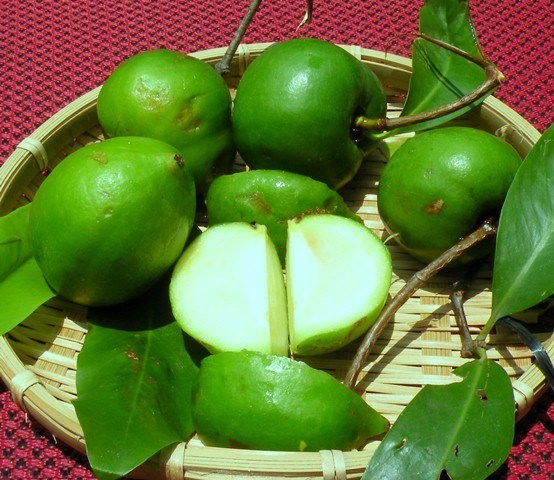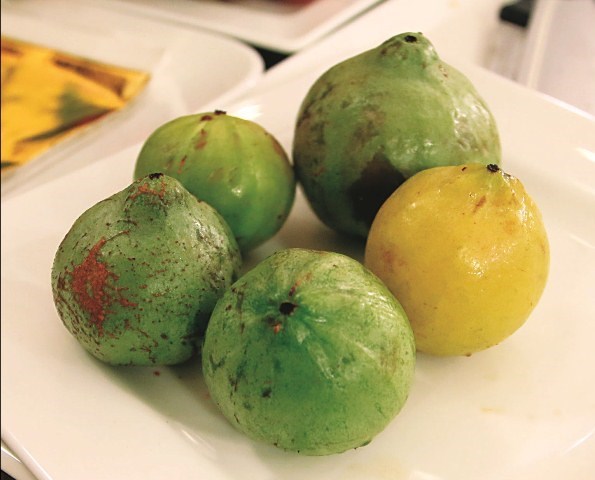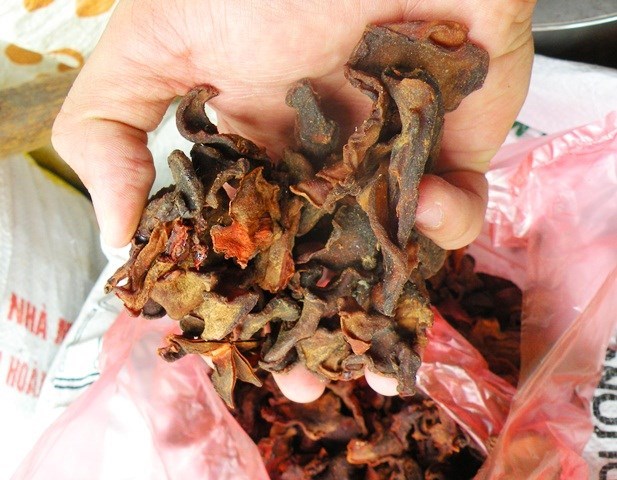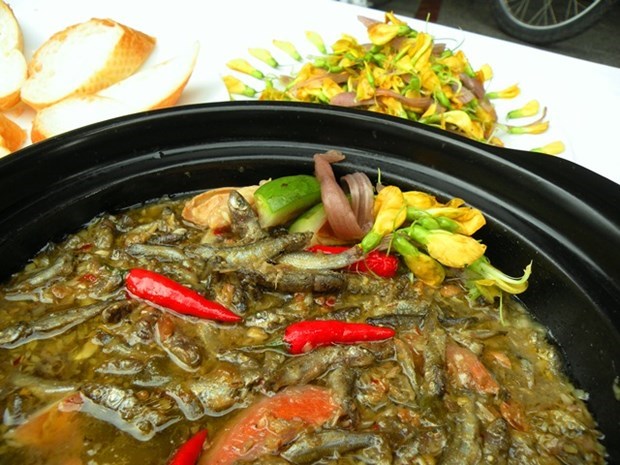There are always some delightful secrets hidden in rustic appearance in the world of wild plants. A lively example is gamboge fruit.

An Giang gamboge fruits.
Transparence
The very first time I met this fruit was at Cham village,
Chau Giang (also known as That Son legendary land). I had discovered the transparent
taste of gamboge fruits - a light scent carried a hint of sour - from a small bowl
of liquid seasoning. This compelling taste recalled the taste of tamarind fish
sauce in which tamarind has to be grilled till brown then mashed with some hot
bird pepper.
This type of sauce is usually used for grilled fish, such as
golden catfish or rice-field climbing perch. However, it still fits on red
meat. Chams also use gamboge fruit sauce with beef tenderloin. Chams community
tends to consume their own products, and each home-raised cow can provide only
about 400g of tenderloin.
Mrs. Cam’s daughter brought a whole chunk of beef tenderloin
and placed it on heating charcoal. She coated the beef with a bit vegetable oil
to protect its moisture. Without seasoning but the slice of beef was just
perfectly tasty, smooth, and super tender. However, these beef slices would be
monotonic if there was not a bit of gamboge fruit sauce. The transparent
sourness together with particular fish sauce scent amazingly enriched the taste
of grilled beef, which was served with pickled onions and ong-choy.
Is it considered as the
summit of An Giang casual delicacies? If so, we have to appreciate Chams who
shared their great gamboge fruit sauce recipe to us. We should have known that gamboge
shells are thick and sappy (mangosteen-like) which can cause throat-itchy but
if we pick mature fruits, burn them, then collect the yellowish flour inside,
we will have a very interesting seasoning.

Another type of gamboge fruits from the Middle of Viet Nam, guava-like looking.
Moreover, gamboge leaves are also a great vegetable even
though their appearance is not significantly different from other wild leaves.
Older from Seven-Mountains area persisted that without gamboge leaves, pancake
stuffed mountain chicken would be much less delicious.
As its origin, gamboge rather consists with casual meetings than
luxurious parties. A restaurant owner, who just came back from vacation,
excitedly shared “Gamboge trees grow as
dense as forest in Phu Quoc island. I fish a bunch of excellent black grouper
but couldn’t find a piece of Giang leaves to cook a bowl of sweet and sour
soup. But local people showed me how to cook it with gamboge leaves. Such an
exotic soup! I wish I have enough gamboge leaf supply so that I could get big
money from curious Saigon people.”
The good new is that, today, fusion cuisine (combine elements of
different culinary traditions) has become a rising trend among
progressive chefs in Ho Chi Minh city. This is a great opportunity for young
enthusiastic chefs, and hopefully also a chance for rustic gamboge fruits to
step on classy dinning table.
Harmony
Let’s listen to a “conference” of a dozen young chefs at a
coffee shop in district 1, Ho Chi Minh City:
“Floating season this
year was so meager. Luckily I’ve got some Linh fish (Henicorhynchus)”, a southwest voice commented.
“Have you guys had
Linh fish and gamboge sour soup yet? Served with seasoned water lily stems and
Dien Dien flowers (Sesbania sesban).”
“Not as cool as my
gamboge sauce over fresh bread”, confidently said another southern girl.

Northern gamboge, sold at Dong Xuan market (Ha Noi) and other grocery kiosks in HCM city.
It’s so amazing to see
how gamboge flour blends in salty fermented soya and homemade fish sauce to
rise up the taste of modern styled Linh fish in hot pot. Among those
ingredients, the probiotics of fermented soya plays a role of a peacemaker,
which retrains fishy smell and quietly increases the savory of main
ingredients.
To be fair, gamboge
fruits have an ungainly face but amazing taste. Therefore, adept chefs can
easily mix it with suitable ingredients to make affective harmony out of them.
There was a time when Nga
Restaurant (Dis. 1, HCM city) owner and I have a drink and social talk and he
accidentally revealed his secret of making addictive Carb fish Bun Rieu, that
was gamboge’s twin called “sour ears” (Garcinia cowa). This name is
strange with Southern people because its origin is the North, from Ha Tinh
province up to northern border. Local people there collect mature fruits,
thinly slice, and sun-dry them until they’re totally dried out and ear-like. By
doing that, they significantly reduced sap from shells. At Dong Xuan market, Ha
Noi city, a second-class sour ears’ price is about 120,000 – 140,000 vnd per
kilogram but jumps to 250,000 vnd per kilogram in Ho Chi Minh city. But best is
cheapest, only a few ears about 50g can season 2 litters of broth. An 3 grade
cooking expert, Ms Nguyen Thi Tuyet (Dong Da dis., Ha Noi) said “Stewed duck
with Sau fruits (Dracotomelon) just uses Sau to beautify the dish because taste
of Sau fruits is extremely sour. Sour ears juice is a “must have” ingredient to
back it up.”

Linh fish in hot pot, precursor of fusion dish named “Linh fish in gamboge sauce, served with fresh bread.
Back to the South, it
seems that working class and youngsters have rather hooked to the synthetic
sour spice of Thailand instant noodles than the transparent, ardent sourness of
gamboge fruits.
Just to think, the
Southeast countries have shared the same spice-fruits, such as wild limes,
gamboge, Quach (Limonia acidissima) in which wild lime was registered as
Thai’s properties years ago and it has used in mass production. On the other
hand, we have still stayed with traditional and “romantic” method of using this
rustic gamboge.
By Ta Thi/Nguoi Do Thi